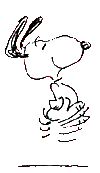
It's unsettling when your dog has a fear of thunder, fireworks or other loud and sudden noises. Dogs often express their fear in destructive behavior, barking, cowering, and throwing various fits.
There are two mistakes we often make which only make the situation worse:
-
Never reprimand or punish the dog for being afraid - He will only become more frightened.
-
Never verbally or physically try to reassure or comfort the dog when he is acting fearful - If you stroke, cradle or hug your dog while saying things like, 'Oh poor baby, it's OK, there's nothing to be afraid of,' the dog doesn't understand your words, but he does understand that he is receiving a gentle, soothing reward by your actions and tone of voice. The dog usually concludes it is doing the right thing by acting nervous because you are so approving of it.
Sometimes simply stopping the unintentional reward stops the fearful behavior. But until the dog is over his fears, it is best to confine him to a place where he can't hurt himself or completely destroy your property. A crate is ideal. Accustom the dog to his special place so that he feels comfortable and secure there. Don't wait until the storm has arrived to introduce your dog to his 'safe haven.'
Below are two methods to help your dog to overcome his fear of thunder, fireworks and other loud noises:
Method 1 - Distraction Training And Fear
Brush up on some obedience training and teach your dog a few tricks and games. It is difficult for a dog to be afraid when he is enjoying his favorite game of fetch. It is difficult to think about the thunder storm outside when he is concentrating on a quick series of Come, Sit, Heel, Sit, Shake Hands, Down, Roll Over, etc. The idea is to distract the dog from the noise. You can then shower the dog with lots of affection and attention, but for obeying a simple command of sit-shake hands, instead of for acting fearful.
The key is patience and practice. Do not wait until the night before the thunder storm or the third of July (fear of fireworks) to begin teaching your dog a few tricks. Be sure he knows them well beforehand. He will probably have trouble concentrating at first, so the better he knows the games and tricks, the easier it will be for him to perform them under pressure.Method 2 - Desensitization And Fear
Another method of helping your dog overcome his fear is to slowly and gradually accustom him to the noises that frighten him. This can be done by making a recording of the sounds and playing it back to the dog while he is enjoying everyday life and activities. Many music stores have soundtracks of fireworks, thunder storms and rain that you can purchase. Start by playing it back at such a low volume that you can barely hear it, but the dog's keen hearing will. The dog should show no signs of fear at this volume. Gradually, over the course of weeks or months, increase the volume by tiny increments. The volume is increased so slowly that the dog hardly notices the change. Eventually he will be used to hearing the sounds at full force. If at any time, your dog shows signs of fear, decrease the volume again and proceed a little more slowly. This procedure will work more quickly if you combine it with distraction training.
Remember to praise your dog abundantly when he does the right thing!












